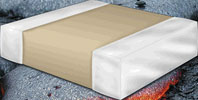New MLCC dielectrics from Kemet
3 February 2010
Passive Components

Kemet has expanded its high-temperature product portfolio with the addition of new UltraStable X8R and X8L dielectric platforms. SMD MLCCs utilising these dielectrics feature a 150°C maximum operating temperature. Product applications include harsh environments such as down-hole (oil exploration), automotive (under the hood), military and aerospace.
UltraStable X8R dielectric features a 150°C maximum operating temperature, with the same temperature capability as conventional X8R, but without the capacitance loss due to applied DC voltage. UltraStable X8R exhibits no capacitance loss and is a suitable replacement for higher capacitance and larger footprint devices that fail to offer capacitance stability. Six standard package options are available which include EIA 0402, 0603, 0805, 1206, 1210, and 1812 case sizes. Devices are available in DC voltage ratings of 25 V, 50 V and 100 V, with capacitance offerings ranging from 10 pF to 0,22 μF. Capacitance tolerance offerings include ±1%, ±2%, ±5%, ±10% and ±20%, with capacitance shift limited to ±15% from -55°C to +150°C.
X8L dielectric offers an operating temperature range from -55°C to +150°C with capacitance shift limited to ±15% from -55°C to +125°C and +15/-40% from 125°C to 150°C. Five standard package options are available which include EIA 0402, 0603, 0805, 1206 and 1210 case sizes. Devices are available in DC voltage ratings of 10 V, 25 V and 50 V, with capacitance offerings also ranging from 10 pF to 0,22 μF. Capacitance tolerance offerings include ±5%, ±10% and ±20.
Both platforms are environmentally friendly in compliance with RoHS legislation and are being offered in both commercial and automotive grades with 100% pure matte tin-plated terminations that allow for excellent solderability. Sn/Pb termination is also available upon request, with a flexible termination option becoming available in the near future.
Further reading:
Vibration-resistant axial capacitors
RS South Africa
Passive Components
TDK Corporation has unveiled the B41699 and B41799 series of ultra-compact aluminium electrolytic capacitors, engineered to withstand operating temperatures of up to 140°C.
Read more...
Capacitors for demanding industrial applications
Passive Components
TDK Corporation has announced its X1 capacitors of the EPCOS B3291xH/J4 series for power line filtering of electromagnetic interferences in demanding automotive and industrial applications with a rated AC voltage of up to 480 V.
Read more...
Wide frequency range inductors
RS South Africa
Passive Components
TDK Corporation has expanded its ADL4524VL series
(4,5 x 2,4 x 2,6 mm – L x W x H) of wire-wound inductors for automotive power-over-coax.
Read more...
Cutting-edge hybrid capacitors
Avnet Silica
Passive Components
Panasonic Industry recently announced the launch of the ZVU Series Hybrid Capacitors, a cutting-edge solution tailored to meet the escalating demands of advanced electronic systems.
Read more...
Low-profile tantalum chip capacitors
Electrocomp
Passive Components
These general-purpose tantalum capacitors from Kyocera AVX are available in multiple case sizes with low profile options.
Read more...
Coupled inductor for high-performance applications
Passive Components
This coil with MnZn core is characterised by its high permeability and extremely low RDC values, which achieves excellent power density and very high efficiency.
Read more...
Power inductors
iCorp Technologies
Passive Components
he HTF-MP series is more suitable for complex multiphase power supply applications in design, effectively meeting the needs of ultra-thin and high-power devices.
Read more...
SMT power inductors
Future Electronics
Passive Components
The Würth Elektronik WE-MXGI SMT power inductors are the latest addition to Würth Elektronik’s moulded power inductor series, engineered for high-frequency power applications.
Read more...
Large capacitance MLCCs at 100 V
RS South Africa
Passive Components
TDK Corporation has expanded its CGA series for automotive multilayer ceramic capacitors to 10 µF at 100 V in 3225 size.
Read more...
Film and mica capacitors
Actum
Passive Components
By utilising various polymer dielectrics plastics, Exxelia film and mica capacitors meet most technical requirements and serve all functions from standard filtering to specialised applications.
Read more...


